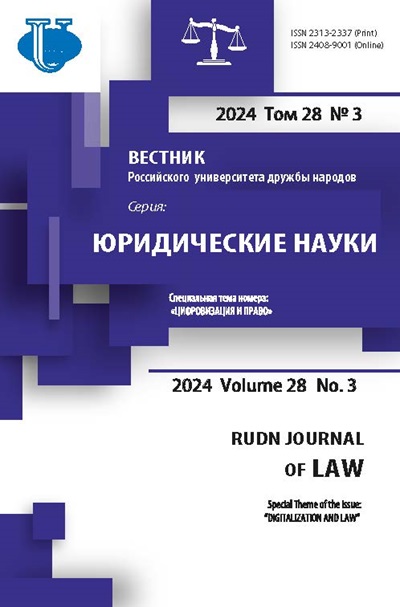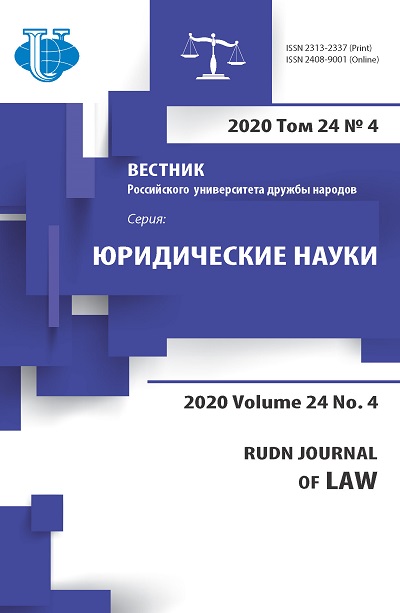ЗАКОНОДАТЕЛЬНЫЕ ФОРМЫ КОНКРЕТИЗАЦИИ ПРАВА
- Авторы: Довгань К.1
-
Учреждения:
- Академия труда и социальных отношений
- Выпуск: Том 24, № 4 (2020)
- Страницы: 864-880
- Раздел: ГОСУДАРСТВО И ПРАВО В СОВРЕМЕННОМ МИРЕ
- URL: https://journals.rudn.ru/law/article/view/25243
- DOI: https://doi.org/10.22363/2313-2337-2020-24-4-864-880
Цитировать
Полный текст
Аннотация
Стабильность и качество законодательства проверяется временем. Органичное развитие права и элементов правовой системы позволяет обеспечить защиту основных прав и свобод человека и гражданина. В условиях модернизации современной жизни, в том числе в период серьезных эпидемиологических потрясений, эффективность принимаемых правовых актов приобретает существенное значение. Особенно это важно в период обновления законодательства. Эффективность и единство правового регулирования позволяет оценить «рамочное» законодательство. Мы рассмотрели законодательные формы конкретизации «рамочного» законодательства на разных уровнях правового регулирования. Методология исследования определена ее источниками. Применение формально-юридического метода исследования позволило проанализировать правовые акты в системе. Одним из основных механизмом реализации “рамочного” законодательства является конкретизация, которая позволяет сбалансировать правотворческую, правореализационную и правоприменительную деятельность. Благодаря определенной степени обобщенности и абстрактности, направлению правового регулирования, заданные на уровне рамочного акта ключевые посылы детализируются, конкретизируются в соподчиненном акте. Индивидуализация общественных отношений способствует правильному применению юридических норм. Если рассмотреть с технико-юридической точки зрения, то можно проследить применение такого средства правового регулирования как «неопределенность», создаваемое законодателетем в целях регулирования новых общественных отношений и конкретизации их на последующем уровне правового регулирования с учетом временных, социально-экономических, процедурных, идеологических и иных критериев. Гибкая форма правого регулирования путем абстрактного способа формулирования норм права используется в рамочных актах, что открывает новые возможности для эффективного правового регулирования.
Об авторах
Ксения Довгань
Академия труда и социальных отношений
Автор, ответственный за переписку.
Email: dok2122@bk.ru
кандидат юридических наук, доцент
119454, г. Москва, ул. Лобачевского, д. 90Список литературы
- Алексеев С.С. Общая теория права: в 2 т. Т. I. М.: Юрид. лит., 1981. 361 с.
- Арзамасов Ю.Г. Ведомственное нормотворчество: понятие и функции // Государственная служба. 2003. № 4(24). С. 120-123.
- Баранов В.М. Очерки техники правотворчества. Избранные труды: монография. М.:Юстиция, 2017. 585 с.
- Баранова М.В. (2016) Опережающее правотворчество в правовой системе современности // Вестник Саратовской государственной юридической академии. № 1. 2016. С. 43-45.
- Бошно С. В., Пытикова Т.А. Приказ: нормативный или правоприменительный акт? // Юрист. 2005. № 10. С. 10-12.
- Черданцев А.Ф. Правовое регулирование и конкретизация права // Применение советского права: Сборник статей. Свердловск, 1974. C. 15-37.
- Ефремова, Т.Ф. Новый словарь русского языка. Толково-словообразовательный. М.: Русский язык, 2000. 1232 с.
- Халафян Р.М. Использование международных норм в качестве средства обеспечения правового качества нормативных правовых актов российской федерации // Вестник Института законодательства и правовой информации им. М.М. Сперанского. 2017. № 1 (42). С. 29-37.
- Knut, L. (2011) Constitutional and legal protection of the right to food worldwide, available at: https://en.wikipedia.org/wiki/Framework_law. (Accessed 01 June 2020).
- Корабельникова Ю.Л., Янин Ю.В. Роль ведомственного нормотворчества в государственном правотворчестве // Академическая мысль. 2019. № 1 (6). С. 55-58.
- Крохина Ю.А. (2001) Правотворчество субъектов Российской Федерации в бюджетной сфере // Журнал российского права. 2001. № 5. С. 70-77.
- Лазарев В.В. Пробелы в праве и пути их устранения. М.: Норма, 2018. 184 c.
- Poduzova, E.B. (2017) Framework Contract (Contract with Open Terms and Conditions): The First Results of the Civil Law Reform. Lex Russica. 6 (127), 116-128. (in Russian). Подузова Е.Б. Рамочный договор (договор с открытыми условиями): первые итоги реформы гражданского права // Lex Russica (Русский закон). 2017. № 6 (127). С. 116-128.
- Поленина С.В. Законотворчество в Российской Федерации. М.: Институт государства и права РАН, 1996. 146 с.
- Senjakin, I. N. (2007) Federalizm kak princip rossiiskogo zakonodatel'stva. [Federalism as a principle of Russian law]. Saratov: Saratov State Academy of Law Publ. (in Russian). Сенякин И.Н. Федерализм как принцип российского законодательства. Саратов: Саратовская гос. акад. права. 2007. 502 с.
- Сивицкий В.А. Теоретическая модель единого нормативного правового (многоступенчатого) акта как способа конкретизации норм силы закона // Конкретизация законодательства как технико-юридический прием нормотворческой, интерпретационной, правоприменительной практики: Материалы Международного симпозиума (Геленджик, 27-28 сентября 2007 года). Нижний Новгород: Нижегородская академия МВД России. 2008. С. 172-188.
- Конституционное (государственное) право зарубежных стран. Часть общая. Отв.ред. Страшун Б.А. М.: БЕК, 2000. 784 с.
- Большой юридический словарь. Под ред. Сухарева А.Я., Крутских В.Е. 2. изд, перераб. и доп. М.: ИНФРА-М, 2002. 703 с.
- Сыманюк Н.В. Эволюция и формы конституционно-правового регулирования порядка распределения компетенции в федеративных системах России и Германии // Российское право: образование, практика, наука. 2014. № 2 (83). С. 108-113.
- Тихомиров Ю.А. Международные правовые акты: природа и способы влияния // Журнал российского права. 2002. № 1. С. 101-111.
- Тихомиров Ю.А. Методология анализа и оценки рисков в законодательной деятельности // Юридическая техника. 2015. № 9. С. 49-52.
- Правовые модели и реальность: монография / О.А. Акопян, Н.В. Власова, С.А. Грачева и др.; отв. ред. Ю.А. Тихомиров, Е.Е. Рафалюк, Н.И. Хлуденева. М.: Институт законодательства и сравнительного правоведения при Правительстве Российской Федерации: ИНФРА-М, 2014. XIV. 280 с.
- Толстик В.А. К вопросу о зависимости между степенью конкретизации норм права и иерархией источников права // Конкретизация законодательства как техникоюридический прием нормотворческой, интерпретационной, правоприменительной практики: Материалы Международного симпозиума (Геленджик, 27-28 сентября 2007 года). Нижний Новгород: Нижегородская академия МВД России. 2008. C. 117-126.
- Венгеров А.Б. Конституционный контроль в СССР // Правоведение. 1970. № 3. С. 32-35.
- Власенко Н.А. Конкретизация в праве: природа и пути исследования. Конкретизация законодательства как технико-юридический прием нормотворческой, интерпретационной, правоприменительной практики // Конкретизация законодательства как технико-юридический прием нормотворческой, интерпретационной, правоприменительной практики: Материалы Международного симпозиума (Геленджик, 27-28 сентября 2007 года). Нижний Новгород: Нижегородская академия МВД России. 2008. С. 57-68.
- Власенко Н.А. Неопределенность в праве: природа и формы выражения // Журнал российского права. № 2 (194). 2013. С. 32-44.
- Власенко Н.А. Конкретизация в праве: методологические основы исследования // Журнал российского права. № 7 (211). 2014. С. 60-75.
- Власенко Н.А. Разумность и определенность в правовом регулировании. Москва: ИНФРА-М. 2014. 154 с.
- Официальное толкование норм права / Вопленко Н.Н. М.: Юрид. лит, 1976. 118 с.
- Залоило М.В. Опережающий характер правотворчества и проблема синхронизации правового регулирования // Журнал российского права. 2019. № 9. С. 20-29.
- Залоило М.В. Пределы и техника конкретизации юридических норм в правотворчестве // Журнал российского права. 2014. № 11. С. 34-41.
- Залоило М.В. Правоприменительная конкретизация юридических норм // Журнал российского права. 2012. № 8. С. 50-56.
















